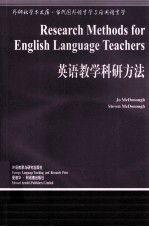

英语教学科研方法PDF电子书下载
- 电子书积分:11 积分如何计算积分?
- 作 者:(英)麦克多诺(McDonoughJ.)等著;刘润清导读
- 出 版 社:北京:外语教学与研究出版社;爱德华·阿诺德出版社
- 出版年份:2012
- ISBN:7560085296
- 页数:267 页
Introduction:setting the scene 1
Part 1:principles and perspectives 5
1.Teachers in action 7
Introduction 7
Context and roles 8
Instances 10
Patterns of research:implications 14
Conclusion 17
Discussion notes 19
2.The teacher researcher in focus 21
Introduction 21
Action and reflection 22
A short educational excursion 25
Teacher research and English language teaching 28
Conclusion 34
Discussion notes 35
3.What is research? 37
Introduction 37
General views 37
Common views of what research in language teaching does 41
Basic and applied research 42
Description and intervention 44
Normative and interpretive research 47
Conclusion 54
Discussion notes 55
4.Principles and problems:what makes good research? 57
Introduction 57
Features of good research 57
Comparison of research traditions on these features 69
Aspects of design of research 70
Conclusion 72
Discussion notes 73
5.Generating research 75
Introduction 75
Beginnings 75
Approaches 78
Content:teachers'choices 81
Research and research:existing work 84
Conclusion 88
Discussion notes 89
Part 2:topics and methods 91
6.Definitions and overview 93
Principles,methods,techniques 93
Introduction to methods and techniques 95
Out there:discovering other people's work and telling them about one's own 96
7.Observing language classrooms 101
Introduction 101
Observation:uses and perspectives 101
Systematizing observation 105
Alternatives to coding schemes 111
Naturalistic observation 114
Conclusion 118
Discussion notes 119
8.Diaries and diary studies 121
Introduction 121
Some definitions 121
Diary data 122
Diaries in language learning and language teaching 127
Keeping a diary 134
Conclusion 136
Discussion notes 136
9.Using numbers 137
Introduction 137
Why count,and what to count 138
Describing the numbers with other numbers 139
Inference from chance-'significance' 150
Computational aids 152
Conclusion 153
Discussion notes 153
10.Doing experiments 155
Introduction 155
Why experiments? 155
Causality and the method of detail 157
Experiments and quasi-experiments 158
Some examples 161
Reflections on the experimental approach 165
Conclusion 168
Discussion notes 169
11.Asking questions 171
Introduction 171
Questionnaires 172
Interviews 181
Issues in interviewing 185
Conclusion 187
Discussion notes 188
12.Looking inside:methods for introspection 189
Introduction 189
Introspection 190
Verbal report and think-aloud 191
Research on oneself 194
Research on learners 196
Some examples 200
Conclusion 201
Discussion notes 202
13.Studying cases 203
Introduction 203
What is a case? 203
Methods in case study research 207
Case studies in language learning and teaching 209
The controversy of case study 216
Conclusion 218
Discussion notes 218
14.Mixing research methods 219
Introduction 219
Principles in mixing methods 219
Teachers'research:some continuing case studies 225
Conclusion 231
Discussion notes 232
Conclusion 233
The role of research by teachers 233
Appropriate methodologies 234
Development of criteria 235
'Popularity'of various techniques 236
Teacher research and higher-degree research 236
Evaluations of teacher research 237
And finally 239
Appendix 241
References 247
Index 257
文库索引 263
- 《中风偏瘫 脑萎缩 痴呆 最新治疗原则与方法》孙作东著 2004
- 《高级英语阅读与听说教程》刘秀梅编著 2019
- 《思维导图 超好用英语单词书》(中国)王若琳 2019
- 《培智学校义务教育实验教科书教师教学用书 生活适应 二年级 上》人民教育出版社,课程教材研究所,特殊教育课程教材研究中心编著 2019
- 《初中生英语作文 提高篇》清瑶主编 2019
- 《指向核心素养 北京十一学校名师教学设计 英语 七年级 上 配人教版》周志英总主编 2019
- 《培生高级英语语法 练习册》培生教育 2019
- 《365奇趣英语乐园 世界民间故事》爱思得图书国际企业 2018
- 《新课标背景下英语教学理论与教学活动研究》应丽君 2018
- 《幼儿英语游戏活动指导与实训》苏小菊,任晓琴主编;颜晓芳,覃静,谢恬恬,钟博维副主编 2020
- 《断陷湖盆比较沉积学与油气储层》赵永胜等著 1996
- 《古代巴比伦》(英)莱昂纳德·W.金著 2019
- 《BBC人体如何工作》(英)爱丽丝.罗伯茨 2019
- 《一个数学家的辩白》(英)哈代(G.H.Hardy)著;李文林,戴宗铎,高嵘译 2019
- 《莎士比亚全集 2》(英)莎士比亚著,朱生豪等译 2002
- 《莎士比亚戏剧精选集》(英)威廉·莎士比亚(William Shakespeare)著 2020
- 《莎士比亚 叙事诗·抒情诗·戏剧》(英)威廉·莎士比亚著 2019
- 《亚历山大继业者战争 上 将领与战役》(英)鲍勃·本尼特,(英)麦克·罗伯茨著;张晓媛译 2019
- 《孩子们的音乐之旅 1 宝宝睡觉 幼儿版》包菊英主编 2016
- 《液固旋流分离新技术》中国化工学会组织编写;汪华林等著 2019
